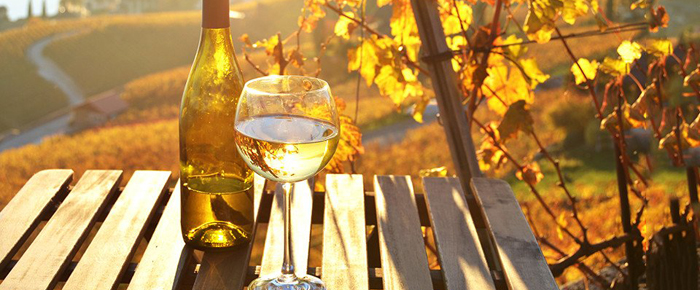
By Rick Riozza
Isn’t it aromatic!! Sometimes some types of wine can knock your sensory socks off.
Aromatic wines are simply fun and festive with their out-of-the-box scents and flavors. They easily open the eyes of the usual Chardonnay and Cabernet Sauvignon drinker as the wines register strong aromas and vibrant savors.
Of course all wine is aromatic; indeed, 70-75% of a wine’s taste comes from its smell. But there are special grapes out there whose sweet-smelling molecules are “Olympically” jumping off the charts.
As we transition from the white wines of summer to the reds of winter, we are blessed with an autumn move of vivacious golden vino. Ok—not all of it is golden, but, there is a harvest tinge to a lot of them. Certainly, these aromatic wines can be made sweet—but apart from the different traditional category of “dessert wines” which of course are delicious, the more interesting of the “non” dessert wines are produced dry or off-dry (i.e., not sweet or just a touch).
The prominent aromas come from the grape itself and not really from other factors, like oak for instance. White aromatic wines are often described as having tropical fruit, exotic flowers and perfumed characteristics. And there’s probably no quick definition for what characterizes an ‘aromatic white,” but they are fermented in stainless steel or concrete, so the aromas reflect the fruit and not the barrel. They are picked at brix (sugar) levels that ensure naturally high acidity and low to moderate alcohol levels. In the glass and in the mouth they display fresh fruit, especially citrus, harvest fruits, along with floral and mineral highlights.
More often than not, the vines are planted on marginal soils, in cooler areas or higher elevations. Last week, you’ll remember our coverage of Gewürztraminer and the northern Italian mountainsides where the vineyards are found. So yes—we did cover “the King of Aromatics” Gewürztraminer, that is perhaps the most effusively perfumed of all the best-known in this category. Other very popular classic white aromatic grape varieties include Riesling and Viognier.
But to talk about Gewürztraminer again, its tropical fruit (lychees for certain) and floral (think rose petal) aromas can be so powerful that you can forget coming up on someone stealthily—they’ll smell you and your glass a yard away. Dry or off-dry Gervursts, with all or most of their residual sugars lacking still provide full fruit flavors that cause one to think it’s sweeter than it is; but the complexities of these wines causes one to pause and savor the golden liquid before you: clearly it’s autumn in a glass.
With such aromatic wines as Gervurst and the ones discussed below, they aren’t the usual sippers such as Chardonnay, Sauv blanc, or Merlot. Aromatics entertain us as a change of pace—something to enjoy to every so often; Special occasions, festivities or quiet time, and—as we write often, they go so well with spicy Asian dishes as they match flavors and herbs of the dish and the alcohol is low to handle well the heat of the chilies. Watch out!—dry versions of aromatics can be rather habitual.
Not to get too nerdy, but, of course—there are also semi-aromatic varieties, whose intensity varies according to where they are grown. We’ve talked about these before such as Pinot gris (or Pinot grigio as it is called in Italy) which often produces a rather neutral white wine, except when it’s grown in France’s Alsace region, or Germany, Austria, and in our part of the world, Oregon and Washington State . All these places can also arouse something special from this grape, developing intense honey, nut and floral characteristics.
Another semi-aromatic variety is our favorite Sauvignon blanc, which we talked about throughout the summer. In warm or moderate climates (like Napa Valley) the fruit is often nicely subdued. But put Sauvignon in the New Zealand setting, and your glass explodes with heady green and tropical fruit aromas.
Among the leading aromatic whites globally, such as Gevürzt, Pinot Blanc, Pinot Gris, Riesling and Viognier, fortunately they do well and are well-suited to the unique terroirs of the Pacific Northwest. The northern Willamette Valley, Columbia Valley and Canadian Okanagan all have conditions that favor the production of these wines. It’s a great theme at your wine tasting parties to match and compare the same varietals from European and the U.S.
Riesling [REE-sling] is well known and comes in many styles. Powerfully scented, reflecting flowers, minerals, apples, lime, and honey. While Riesling is often known as being on the sweeter side, again, the dry expressions can work magic. Try a German Kabinett from the Rheingau region—so wonderful with brunch.
Pinot Gris/Grigio has a long history in the Northwest, and is now the third most planted white wine grape in Washington. Oregon produces a style that is rich and fleshy with luscious flavors of fresh-cut pears and cinnamon spice. Washington’s style is brighter and tart.
Viognier [Vee-o-NYAY] has become lately the boutique winery’s dream, allowing the winemaker to play with the grape’s seductive aromas of peach, tangerine, and big-time honeysuckle. This one is a full-body wine—a bit higher on the alcohol
The best Viogniers are right on the edge of ripeness, retaining their acidity without bitterness, and reaching for fruit without becoming flabby. Best consumed lightly chilled, to keep the alcohol at bay.
Here’s to the beautiful fall season—Cheers!












































